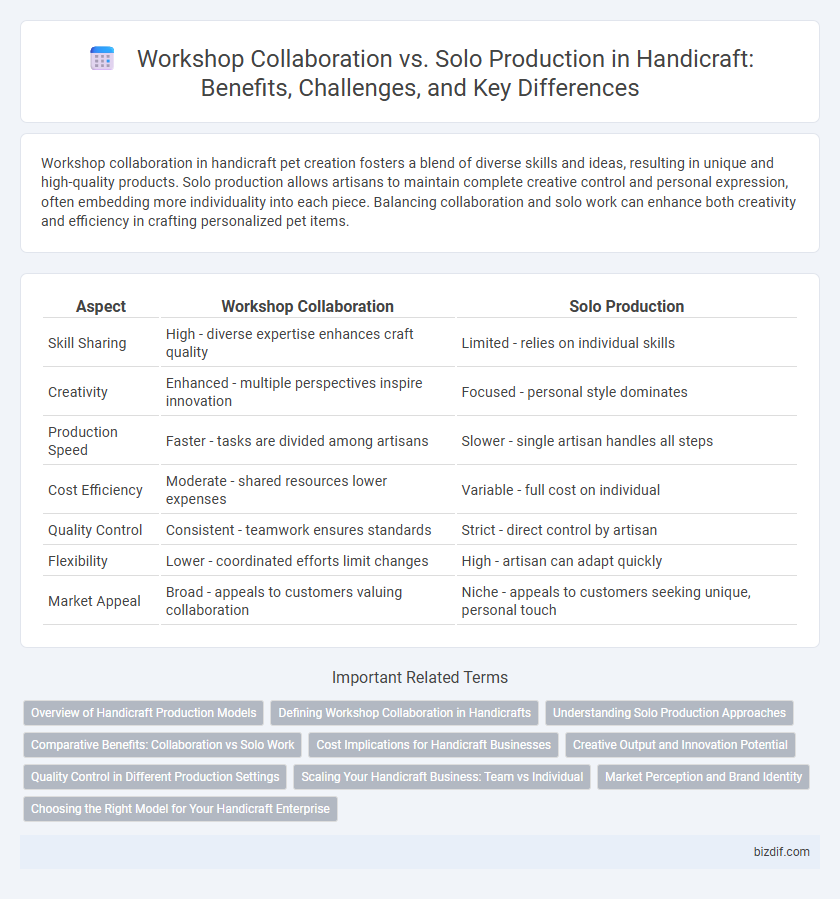Workshop collaboration in handicraft pet creation fosters a blend of diverse skills and ideas, resulting in unique and high-quality products. Solo production allows artisans to maintain complete creative control and personal expression, often embedding more individuality into each piece. Balancing collaboration and solo work can enhance both creativity and efficiency in crafting personalized pet items.
Table of Comparison
| Aspect | Workshop Collaboration | Solo Production |
|---|---|---|
| Skill Sharing | High - diverse expertise enhances craft quality | Limited - relies on individual skills |
| Creativity | Enhanced - multiple perspectives inspire innovation | Focused - personal style dominates |
| Production Speed | Faster - tasks are divided among artisans | Slower - single artisan handles all steps |
| Cost Efficiency | Moderate - shared resources lower expenses | Variable - full cost on individual |
| Quality Control | Consistent - teamwork ensures standards | Strict - direct control by artisan |
| Flexibility | Lower - coordinated efforts limit changes | High - artisan can adapt quickly |
| Market Appeal | Broad - appeals to customers valuing collaboration | Niche - appeals to customers seeking unique, personal touch |
Overview of Handicraft Production Models
Workshop collaboration in handicraft production enhances skill sharing, accelerates output, and fosters innovation through collective expertise. Solo production emphasizes individual craftsmanship, allowing artisans to maintain complete creative control and produce highly personalized items. Both models influence quality, scalability, and market reach, shaping the dynamics of traditional and contemporary handicraft industries.
Defining Workshop Collaboration in Handicrafts
Workshop collaboration in handicrafts involves artisans working together, pooling skills and resources to create intricate, high-quality products that combine diverse expertise. This cooperative approach enhances creativity, fosters knowledge exchange, and improves efficiency compared to solo production, where a single craftsman handles all aspects of creation. Effective workshop collaboration leverages specialization and collective problem-solving to achieve superior craftsmanship and innovation.
Understanding Solo Production Approaches
Solo production in handicraft emphasizes individual creativity and skill mastery, enabling artisans to maintain full control over design, materials, and techniques. This approach often results in highly personalized, unique pieces that reflect the maker's distinct style and craftsmanship. Understanding these solo production methods is essential for artisans seeking to develop specialized expertise and create exclusive, one-of-a-kind products.
Comparative Benefits: Collaboration vs Solo Work
Workshop collaboration in handicraft enhances creativity and skill-sharing, leading to innovative designs and improved craftsmanship. Solo production offers greater control over the creative process and allows artisans to maintain a unique personal style without external influence. Collaborative workshops often result in faster project completion due to pooled resources, while solo work provides flexibility in time management and decision-making.
Cost Implications for Handicraft Businesses
Workshop collaboration in handicraft businesses typically reduces production costs through shared resources, bulk purchasing, and division of labor, leading to economies of scale. Solo production often incurs higher material and time expenses due to limited bargaining power and individual workflow management. Choosing between these methods depends on balancing cost efficiency with creative control and product uniqueness.
Creative Output and Innovation Potential
Workshop collaboration in handicraft significantly enhances creative output by pooling diverse skills and perspectives, fostering innovative design solutions that often surpass solo production capabilities. Collaborative environments stimulate experimentation with new techniques and materials, accelerating the development of unique handcrafted products. Solo production may offer complete creative control but typically limits innovation potential due to narrower input and reduced idea exchange.
Quality Control in Different Production Settings
Workshop collaboration in handicraft enhances quality control through collective expertise, enabling precise inspection and consistent standards across products. Solo production allows artisans to maintain intimate oversight on every detail, ensuring personalized craftsmanship but risking variability due to limited feedback. Quality control in collaborative settings benefits from diversified skills and shared responsibilities, while solo production depends heavily on individual skill and meticulous attention.
Scaling Your Handicraft Business: Team vs Individual
Scaling a handicraft business through workshop collaboration enables increased production capacity and diverse skill integration, boosting efficiency and product variety. Solo production offers full creative control and personalized craftsmanship but limits output scalability and growth opportunities. Entrepreneurs must weigh teamwork benefits like shared expertise and faster turnaround against solo challenges including time constraints and limited market reach to optimize business expansion.
Market Perception and Brand Identity
Workshop collaboration enhances market perception by showcasing diverse skills and fostering innovation, which strengthens brand identity through a collective craftsmanship narrative. Solo production emphasizes individual artistry and authenticity, appealing to niche markets that value unique, handcrafted pieces with a personal story. Brands leveraging collaboration often achieve broader market reach, while solo artisans build deeper emotional connections with dedicated customer segments.
Choosing the Right Model for Your Handicraft Enterprise
Selecting between workshop collaboration and solo production depends on scale, skill diversity, and resource availability within your handicraft enterprise. Workshop collaboration fosters innovation through shared expertise and increases production capacity, ideal for meeting larger orders or diversifying product lines. Solo production allows for greater creative control and personalized craftsmanship, suitable for niche markets or bespoke items demanding high artisanal precision.
Workshop Collaboration vs Solo Production Infographic

 bizdif.com
bizdif.com